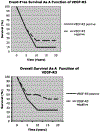Correlation between clinical outcome and growth factor pathway expression in osteogenic sarcoma
- PMID: 19670450
- PMCID: PMC7251638
- DOI: 10.1002/cncr.24562
Correlation between clinical outcome and growth factor pathway expression in osteogenic sarcoma
Abstract
Background: Multiple cell-signaling ligands and receptors-including vascular endothelial growth factor (VEGF), insulin-like growth factor (IGF), endothelial growth factor (EGF), v-akt murine thymoma viral oncogene homolog (AKT), platelet-derived growth factor (PDGF), mitogen-activated protein kinase (MAPK), and 70-kilodalton (kD) protein S6 kinase (p70S6 kinase)-reportedly are variably expressed in osteogenic sarcoma. Expression of these proteins may have future implications for prognostication and targeted therapy. The objective of the current study was to determine the relation between clinical outcome and the expression of these proteins.
Methods: A paraffin-embedded microarray of 48 human osteogenic sarcoma tissue specimens was stained with the antibodies against VEGF, IGF, EGF, AKT, PDGF, MAPK, and p70S6 kinase. Staining for each protein included the total protein and, when applicable, the phosphorylated version of the protein. Immunohistochemical staining was then correlated with patient survival (overall survival [OS] and event-free survival [EFS]), histologic response to chemotherapy, and serum markers.
Results: There was a negative correlation between VEGF receptor 3 (VEGF-R3) and both OS and EFS. VEGF-B was correlated with a poor histologic response to chemotherapy. Serum markers were not correlated with any specific proteins. When using a P value of .05, multiple correlations were observed between proteins of various pathways.
Conclusions: The current results suggested that the VEGF pathway is a critical signaling pathway in osteogenic sarcoma. These data have identified specific proteins within these pathways toward which future investigations should be directed to further clarify their prognostic potential.
Figures


References
-
- Bacci G, Longhi A, Versari M, et al. Prognostic factors for osteosarcoma of the extremity treated with neoadjuvant chemotherapy: 15-year experience in 789 patients treated at a single institution. Cancer. 2006;106:1154–1161. - PubMed
-
- Meyers PA, Schwartz CL, Krailo MD, et al. Osteosarcoma: the addition of muramyl tripeptide to chemotherapy improves overall survival—a report from the Children’s Oncology Group. J Clin Oncol. 2008;26:633–638. - PubMed
-
- Meyers PA, Heller G, Healey JH, et al. Osteogenic sarcoma with clinically detectable metastasis at initial presentation. J Clin Oncol. 1993;11:449–453. - PubMed
-
- Enneking WF, Spanier SS, Goodman MA. A system for the surgical staging of musculoskeletal sarcoma. Clin Orthop Relat Res. 1980;415:106–120. - PubMed
-
- Khanna C, Prehn J, Hayden D, et al. A randomized controlled trial of octreotide pamoate long-acting release and carboplatin versus carboplatin alone in dogs with naturally occurring osteosarcoma: evaluation of insulin-like growth factor suppression and chemotherapy. Clin Cancer Res. 2002;8:2406–2412. - PubMed
MeSH terms
Substances
Grants and funding
LinkOut - more resources
Full Text Sources
Medical
Miscellaneous

